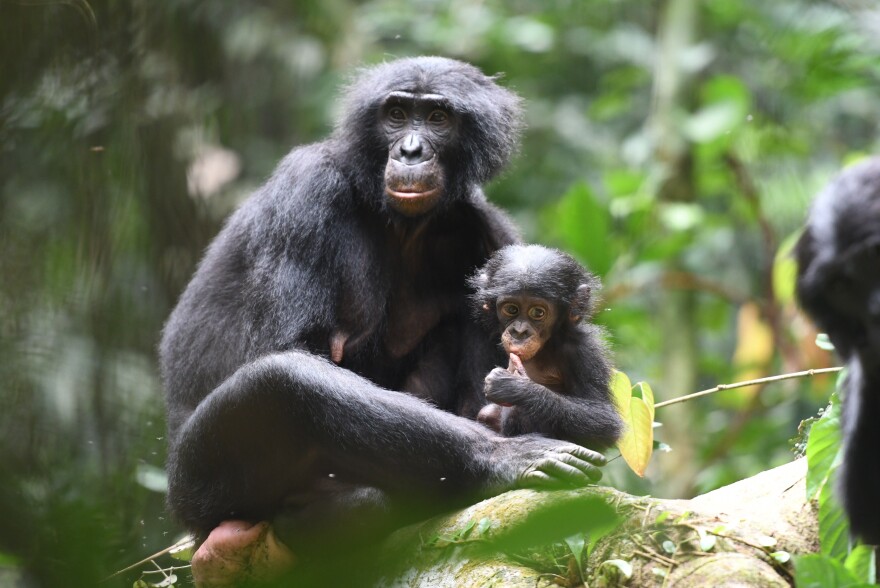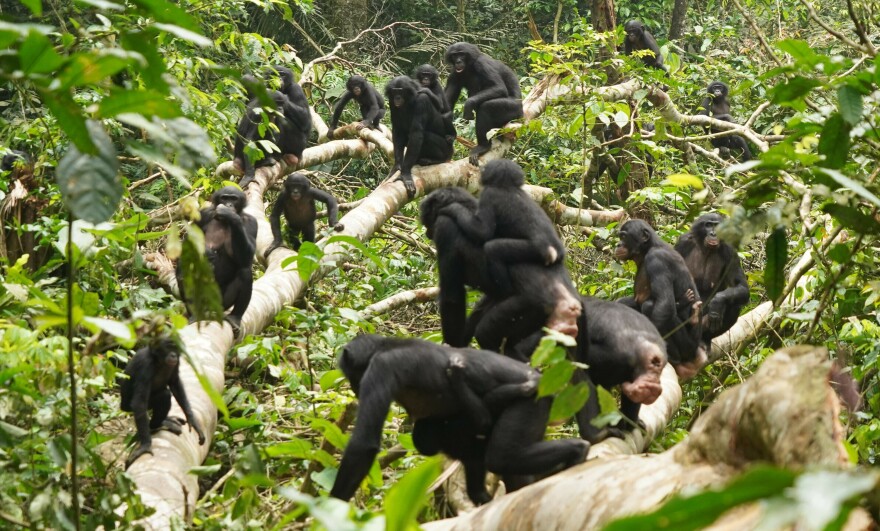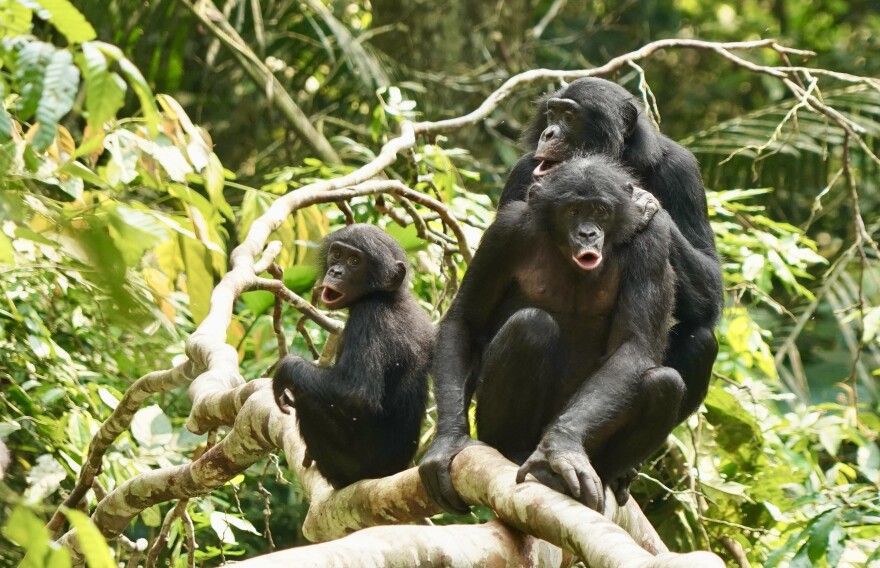As a species, who are we? Are humans innately hostile and violent toward people who belong to communities other than our own? Or are we inherently friendly and cooperative?
These are difficult questions to crack open. Over the years, some researchers — primatologists, evolutionary biologists and others — have tried to make headway by looking to chimpanzees and bonobos, our closest living relatives, for insights.
Now, in a study published in the latest issue of the journal Science, two collaborators argue that wild bonobos — known for friendlier and more peaceful tendencies compared to chimpanzees — cooperate not just within their own communal group but also across other bonobo groups, with more cooperative individuals leading the charge. This paves the way for the broader groups to form social ties.
The researchers say this suggests that warfare may not be humanity's inevitable evolutionary legacy. Cooperation and peace may well be a deep part of who we are too.
That is, both the capacity for war and the capacity for peace may live inside us, alongside one another.

The dark side of chimpanzees
Chimpanzees tend to be the go-to ape for a lot of field research because of their vast and relatively accessible habitat and their close relationship to humans.
Liran Samuni, a behavioral ecologist at the German Primate Center in Göttingen, Germany, has studied different populations of chimps for 12 years. One behavior she's seen frequently is groups of animals on border patrols, quietly and slowly traveling to the edges of their territories to scan for signs of other chimp groups.
"If they do meet other groups, the quiet behavior completely flips," Samuni says. A cacophony of vocalizations ensues. "They scream, they drum on trees."
There's never cooperation between the groups. There's usually chasing. If the number of chimps on each side is fairly balanced, the interaction generally ends without incident.
But if one group outnumbers the other, things get dark — fast.
"It basically turns into physical, very violent attacks, often with the clear intention to kill," says Samuni. "So I'm always a bit on edge during those encounters from fear that something will happen."
It's important for these chimps to stick together to keep from getting isolated, injured or killed.
Since chimpanzees are one of our closest living relatives, does this mean that violence is innate to human nature, too?
It's quite a trek to bonobo land
This is where bonobos offer a helpful counterexample. They're slightly smaller than chimpanzees, they're far less aggressive and we're just as closely related. But because bonobos are endangered and nestled in the remote (and undeveloped, for now) Congo Basin in the Democratic Republic of Congo, they're much harder to study.

"There's no roads leading there," says Samuni. "You either need to rent a boat and do three weeks on a river followed by a walk to camp. Or you have to charter a plane, fly about five hours from Kinshasa to the nearest town to our camp. The next day, you hop on a motorbike and you drive for six hours to the nearest village. And from the village, you walk one more hour to get to camp."
Samuni was up for the challenge. She trekked deep into the Congolese rainforest and stayed there on and off between 2019 and 2021. She followed the bonobos, walking for miles with them day after day.
"We wake up at 4 a.m. in our camps," she says, "brush our teeth quickly and start walking just to get to where the bonobos sleep at night in those nests that they make on the top of the trees." Many days, that meant walking several miles using flashlights to navigate the dark, pre-dawn forest. Then, the actual science would begin.
Once the sun rises, the bonobos climb down, traversing miles as they search for food. Samuni followed them all day, recording their behaviors and interactions until they chose their new sleeping spot. That's when she could return to camp, crash and begin the whole procedure again the following day.
"I have the best tour guides to some of the most pristine areas on this planet," she says, as if admitting to one of her favorite secrets. "This is bonobo land."

Here comes the grooming
Researchers have known that some bonobo groups cooperate with one another. But Samuni and her collaborator, Harvard University evolutionary biologist Martin Surbeck, wanted to learn more about how that cooperation unfolds between two of the groups they work with. Was it random or was there a pattern?
Surbeck has a couple of videos that illustrate what they found. In one, a tree has fallen in the forest. A bunch of bonobos sit along its branches.
He studies the upper right of the frame. "You see a young female approaching this male now, right?," he says. "And they start grooming and removing parasites." Grooming is a form of cooperation. This female and male are members of the two different groups.
The same thing plays out at the bottom of the video — two females from opposite groups grooming one another.
These aren't just any bonobos. Rather, bonobos in one group who were big on grooming were likely to identify the big groomers in another group — and then groom each other.
Surbeck calls up a second video. This time, a few of the bonobos from the different groups are sharing something that looks like a jackfruit. "Doesn't smell particularly nice to be honest," he says, "but I guess that's individual taste and they obviously like it."
The same pattern held. Bonobos that more frequently shared food within their own group were more likely to seek each other out in the other group — and then share food.
It's these highly cooperative individuals (via grooming or food sharing) that end up bringing the rest of the bonobos together. And this initial spirit of cooperation promotes peaceful interactions between the groups.
"For bonobos, cooperation is important because it is proof of love," says Suzy Kwetuenda, who's in charge of animal welfare at Lola ya Bonobo, a bonobo rescue and rehabilitation sanctuary in the DRC. She wasn't involved in the study, but she says the new findings are consistent with what she's observed. Among bonobos, "the most important thing is to be stable, to be in good understanding — more than everything."
Liza Moscovice is a behavioral endocrinologist at the Research Institute for Farm Animal Biology in Germany with a background in bonobos. She wasn't involved in the research either. She says the findings are solid but wishes more attention was paid to who the super-cooperators were.
"Adult females form the core of the social world," she says. "What they don't talk about is whether females overall are cooperating more than males."
In terms of what all this might mean for us, Surbeck says the kind of social behavior they observed in bonobos could be the precursor to modern forms of human cooperation like "trade, exchange of ideas and all the connections between different human groups."
But this doesn't discount all the chimp work. Rather, both species may have something to teach us about where we came from.
"We know that human warfare is something that is quite widespread across societies," says Samuni. "But we also know cooperation is. And I think by looking at chimpanzees and bonobos, you really get to the two sides of the coin."
Copyright 2023 NPR. To see more, visit https://www.npr.org.



